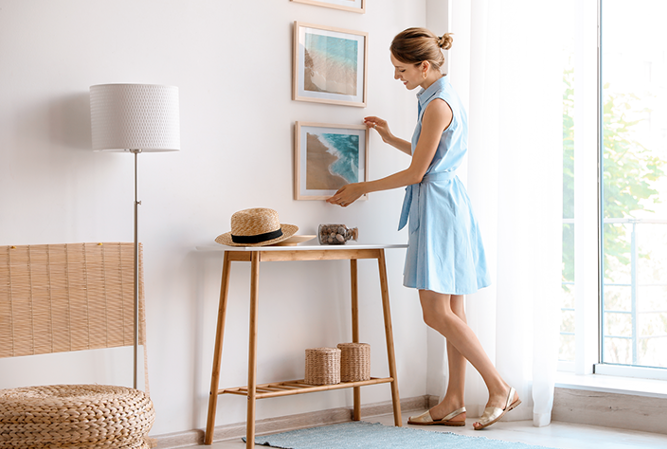During and After a Historic Home Renovation, Following a Few Simple Tips Ensures Your House Meets Your Aesthetic Preferences While Staying True to Its Distinct Design
The privilege of living in a home built in the 1940s and earlier comes with unique challenges – most notably, interior decorating. Because your home is full of historic character, you don’t get the luxury of the blank slate of modern, cookie-cutter houses – but you wouldn’t want that anyway, right?
As your home remodelers, Architectural Craftsmen helps coordinate interior finishes, including painting, tiling, and wood staining in your historic home. Consider these ideas during your home renovation to put the finishing touches on your living spaces.
Tip One: Choose Wall Colors that Mesh Well with the Architectural Era of Your Home
Just as different architectural styles were all the rage, so too, were specific interior wall colors. Your house will look great in hues that align with the original design elements that Architectural Craftsmen renewed during your historic home renovation.
Paint Tip: Most stores specializing in paint offer brochures and color guides for specific architectural styles. Stop in to your favorite paint store to inquire about available literature. Seeing paint samples in person is often a better way to understand how a color will look in real life, rather than looking at them on a computer screen.
If you live in a Victorian: Traditional Victorian homes were painted in earth tones on the inside. Consider rich shades of red, emerald, dark brown, amber, or a blend of them – the colors of success during the Industrial Revolution. Because they’re all related colors, they tie together nicely, so you can use multiple colors across your home.
Choose an accent color from across the color wheel to add in accessories and break up the dark walls. In most cases, light blues, hints of yellow, and dabs of sage green are smart choices.
If you live in a craftsman-style home: The arts and crafts movement produced inviting homes full of character – and your interior paint choices should support that. Look around at your home’s unique features, such as a stained glass window or fireplace finish, and choose a color palette built around those foundational shades.
Highlight woodwork with color – not a neutral tone – to show off wood grain. Some people prefer shaded pastels, while others go for more vibrant, yet earthy hues of yellows, reds, and greens.
If you live in a Tudor Revival: Tudor-style homes are chock full of architectural elements you’ll want to highlight. Choose your favorite, dominant features to focus on, and minimize everything else. Contrast the dark wood beams and trim with warm colors in lighter shades, then accent with a cool color, like green or blues.
For a true Tudor Revival historic home renovation, we don’t recommend painting the original trim, simply from a preservationist standpoint. However, it’s your house – and you may want to paint some of the less detailed trim areas, such as around staircases, to bring your home into the modern era.
If you live in an American foursquare or Kansas City shirtwaist: The floor plan of an American foursquare or Kansas City shirtwaist works well for most families – and these houses are especially wonderful for the amount of natural light they let inside. Play that up with neutral or pale colors that bring out the natural colors in your home’s original woodwork.
Be especially careful when choosing colors. If your woodwork has warm tones (ex: yellow, orange, or red), choose a warmer neutral. If your woodwork has cool tones (ex: gray, blue, green, or black), a cool neutral works best.
Tip Two: Consider Furniture Styles for Your Newly-Renovated Historic Home
If you see a tastefully renovated historic home exterior that has kept true to its original design, you’d expect to see the same inside, too, right? Although you don’t have to be completely married to your home’s original architecture style and ensure every piece of furniture perfectly matches it, it’s a good idea to include some pieces that do.
Design Tip: The right interior designer can help you select important, matching pieces and find sofas, tables, art, and other items that coordinate nicely. Ask your home remodeler – Architectural Craftsmen – for our recommendations.
If you live in a Victorian: When choosing furnishings for a Victorian, more is better. And because there are so many subtypes of Victorian home architecture (Italianate and Queen Anne being the most common you probably think of), you have tons of options for coordinating furniture.
Choose rich, ornately-carved pieces – a cornerstone of Victorian style – and rugs and curtains with bold patterns. Velvet or damask upholstery work well, especially when paired with gilded gold frames to highlight your favorite pieces of art. Play up the style with accessories like lamps, statues, and other curiosities. Victorian homes are unique in that you have carte blanche to be a little ostentatious in your design choices.
If you live in a craftsman-style home: Patterned upholstery and mid-century modern or traditional furniture works well in your craftsman home. Basically, if it’s simple with clean lines – like Mission or Shaker-style furniture – it’ll work for you. Oak and other wood grains should be on display in a few of your pieces – especially because they’ll work so well with the original interior woodwork.
If you live in a Tudor Revival: Living in a Tudor-style home gives you the opportunity to blend furniture styles from all over Old World Europe, including heavy and ornate wooden furniture, elaborate upholstery with tufted cushions, and pedestal tables with high-back chairs. You don’t have to play it safe with a Tudor; the drama of its dark wood tones allow you to incorporate prints and heavy fabrics without overpowering the rest of the house’s signature features.
If you live in an American foursquare or Kansas City shirtwaist: The era your foursquare was built will dictate the architectural style. That’s right, your foursquare or shirtwaist could be craftsman-style, Colonial Revival, or even Kansas City jazz age opulence; our home remodeling crew can tell you all about each of them.
Refer to the craftsman section of this article for more information on decorating your home’s interior. If your home is more Colonial Revival, opt for Sheraton or Chippendale style pieces, Windsor chairs, and elegant four-poster beds, ensuring you highlight the natural light in every corner room. If your home is more KC jazz age, opt for geometric patterns from the Art Deco movement, floral wallpaper, and gilded mirrors.
Tip Three: Browse the Internet for Home Renovation Ideas and Inspiration
Just because you’ve gone forward with a historic home remodeling project doesn’t mean you’re now limited to matching your interior decor to the original architecture. In fact, many owners of distinctive homes have successfully honored their house’s story and character, while injecting it with their own personality.
Get home renovation ideas by browsing online home decor magazines, Pinterest boards, and our portfolio of home remodeling work. Looking at a variety of images can help you decide the path forward to decorating your newly-remodeled home, whether you live in a craftsman, Tudor, Victorian, foursquare, or shirtwaist.
Talk to Us to Learn How We Can Revitalize Your Distinctive Home While Adding Modern Functionality
At Architectural Craftsmen, we believe in protecting and renewing the important architectural elements that make your home special. But we also support the idea that families in Kansas City historic homes should enjoy modern functionality where they live, too.
But rather than erasing your home’s character and filling it with white and gray all over, our expert carpenters and architectural design aficionados bring your house into the current era while respecting the important elements that make it truly distinct.
To learn how we can help you with your historic home renovation, send us a message on our website. We can’t wait to meet you and hear the story your home has to tell.


